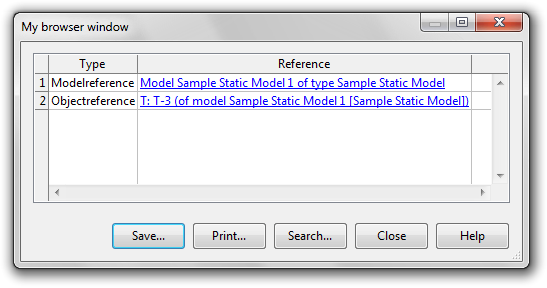BROWSER
BROWSER will fill a table according to the field informations specified by content and display it within a window with the given title.
Syntax
CC "AdoScript" BROWSER title:strValue content:strValue
[ fieldsep:strValue ] [ linesep:strValue ]
[ with-handlecolumn ] [ max-size ]
[ adjust-rows ] [ alignment:strValue ]
[ header:strValue ] [ print-header:strValue ]
[show-links] [ modref-format:strValue ]
[ objref-format:strValue ].
# --> RESULT ecode:intValue CC "AdoScript" BROWSER title:strValue content:strValue
[ fieldsep:strValue ] [ linesep:strValue ]
[ with-handlecolumn ] [ max-size ]
[ adjust-rows ] [ alignment:strValue ]
[ header:strValue ] [ print-header:strValue ]
[show-links] [ modref-format:strValue ]
[ objref-format:strValue ].
# --> RESULT ecode:intValueParameters
title(strValue) - title of the opened windowcontent(strValue) - string from which the content of the window is created. First line contains column headers. The first column of the rows is used as row header, afterwards the content is provided. Line and field breaks are specified with other parameters.fieldsep(strValue, optional) - character that defines the limit of a field. If no fieldsep is given, ';' is supposed to define the field limits.linesep(strValue, optional) - character that defines the end of a table row. If no linesep is given, '\n' is supposed to define the end of a row.with-handlecolumn(modifier, optional) - specifies the type of the table. If this argument is passed, the table has a first gray column (maybe used as row titles). In this case, the topleft field is always empty.max-size(modifier, optional) - when passed, the displayed window will totally fill the screen.adjust-rows(modifier, optional) -alignment(strValue, optional) - defines the alignment of the data columns. The string value has to consist of the letters L for left, C for centered and R for right, one for every data column (the handle column is not taken in account).header(strValue, optional) - sets the header for saving the content with the header option enabledprint-header(strValue, optional) - sets the print header for printing, using a page layout with a headershow-links(modifier, optional) - if passed, the table is able to display links (interrefs). If a cell value has the LEO interref syntax, then this cell value is interpreted as an interref which can be followed by clicking on it.modref-format(strValue, optional) - allow to format such an interref value when displayed within the table, for model references.objref-format(strValue, optional) - allow to format such an interref value when displayed within the table, for object references.
Returns
ecode(intValue) - is either 0 or 1, 0 indicating a successful fill and display. The filling will fail, if the content string is inconsistent, i.e. if the number of columns is not the same in each table row or if (besides the column titles) the table contains no rows.
Details
The information how to interpret the content string is specified by fieldsep and linesep.
Specifying a linesep other than '\n' allows to create a table with cell values that have more lines: \n will then be interpreted as the linebreak within a cell value.
In order to show in the latter case directly the full cell values (i.e. all lines), the argument adjust-rows can be used. If this is given, the heights of the rows are automatically adjusted such that all lines will be displayed.
A linebreak within columnheaders is not supported, '\n' characters there will be converted to blanks!
The expected syntax for an interref cell value is
> REF mt:strValue m:strValue [c:strValue o:strValue].
As format specifiers %t (for the modeltype), %m (for modelname), %c (for classname), and %o (for objectname) are supported.
If modref-format is not given, the default value is "%m (%t)".
If objref-format is not given, the default value is "%o (%c) - %m (%t)".
Both modref-format and objref-format refer to the whole table. So the format for model references resp. object references can be defined only once and is valid for all displayed references in the table!
See Also
Examples
Example 1
CC "AdoScript" BROWSER title:"My browser window"
content:";Column 1;Column 2\tRow 1;Value 11\nAdditional line;Value 12\tRow 2;value 21;Value 22\tRow 3;Value 31;Value 32"
linesep:"\t"
adjust-rows with-handlecolumn alignment:"LR"
header:"Save\nthis header" print-header:"Print\nthis header"CC "AdoScript" BROWSER title:"My browser window"
content:";Column 1;Column 2\tRow 1;Value 11\nAdditional line;Value 12\tRow 2;value 21;Value 22\tRow 3;Value 31;Value 32"
linesep:"\t"
adjust-rows with-handlecolumn alignment:"LR"
header:"Save\nthis header" print-header:"Print\nthis header"will show the following table

Example 2
CC "AdoScript" BROWSER show-links
objref-format:"%c: %o (of model %m [%t])"
modref-format:"Model %m of type %t"
title:"My browser window"
content:";Type;Reference\n
1;Modelreference;REF mt:\"Sample Static Model\" m:\"Sample Static Model 1\"\n
2;Objectreference;REF mt:\"Sample Static Model\" m:\"Sample Static Model 1\" c:\"T\" o:\"T-3\""
with-handlecolumn header:"Save\nthis header" print-header:"Print\nthis header"CC "AdoScript" BROWSER show-links
objref-format:"%c: %o (of model %m [%t])"
modref-format:"Model %m of type %t"
title:"My browser window"
content:";Type;Reference\n
1;Modelreference;REF mt:\"Sample Static Model\" m:\"Sample Static Model 1\"\n
2;Objectreference;REF mt:\"Sample Static Model\" m:\"Sample Static Model 1\" c:\"T\" o:\"T-3\""
with-handlecolumn header:"Save\nthis header" print-header:"Print\nthis header"will show the following table

See Also
Versions and Changes
Available since ADOxx 1.3